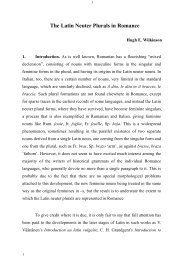THE STRONG PERFECTS IN THE ROMANCE ... - Page ON
THE STRONG PERFECTS IN THE ROMANCE ... - Page ON
THE STRONG PERFECTS IN THE ROMANCE ... - Page ON
You also want an ePaper? Increase the reach of your titles
YUMPU automatically turns print PDFs into web optimized ePapers that Google loves.
this class to have a perfect without g. However, this need not surprise us in<br />
view of the French and Gascon forms, but in this case it seems to be a new<br />
formation. (We can dismiss Dardel’s avessi from Alghero (p. 146) as a<br />
clear Italianism.) Parech, valech, prevalech, calech, tenech we have<br />
referred to in c) above, and they (or casech from caure) seem to have<br />
provided a model for plaech (Fou. R.), and aeg (R.-G.), which seems to<br />
belong to haver. This verb also has the old p.p. aut beside (h)agut.<br />
Catalan, like Gascon, differs from Provençal in having a weak<br />
perfect based on the verb root for saber, caber. There are a few old strong<br />
forms, however. Badía Margarit gives 3 sap, and Russell-Gebbett has<br />
instances of 3 saub and subj. saubessen in a document copied from a<br />
Roussillonese original, and 1 sub and a substantival participial form sobud,<br />
both in a document of the 11th c. with conservative characteristics. Gili (p.<br />
127) also has an infinitive sauber used substantivally. The occurrence of 3<br />
sap beside saub inclines me to believe that in Catalan, as in Gascon, the<br />
tendency was not to anticipate or metathesise the u of Lat. sapui, with the<br />
result that the weak perfect was developed early to avoid confusion with<br />
the present; in this case a form like sabés would come from sapuissem, and<br />
not *sapissem. The p.p. is usually sabut. Caber only has weak cabí, p.p.<br />
cabut. Tenir, venir have old tenc(h), venc(h), and p.ps. tengut, vengut, but<br />
in the perfect the stems ting-, ving-, with i, are also commonly found in the<br />
old language, probably introduced from the pres. subj. rather than reflecting<br />
an old mutation; the modern language regularly has tinguí, tingut, vinguí,<br />
vingut, to avoid confusion with -tendre, vendre (there is confusion with<br />
-tenyer, -tendre, however; see below, §§18, 30). For venir García de Diego<br />
also gives vin, venist, ven, venim, venis (no references), and<br />
Russell-Gebbett has an example of 3 reflexive venesen (but I wonder if this<br />
is a misreading of vencsen, with the usual velar, as seen in the vengra in the<br />
30









